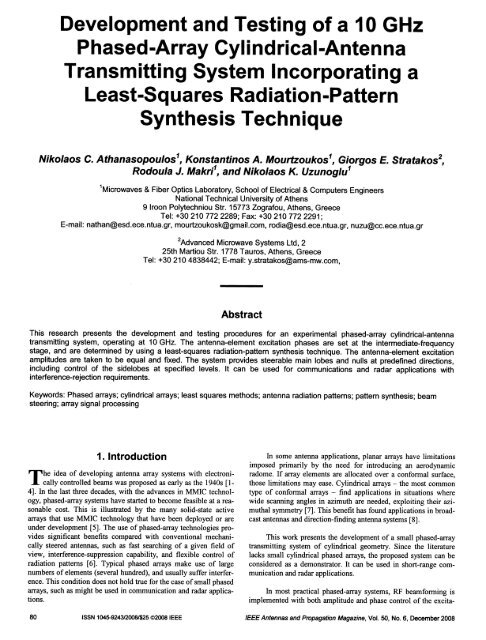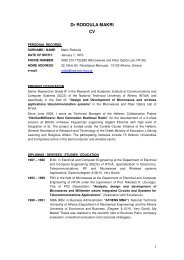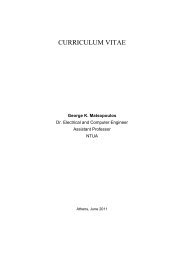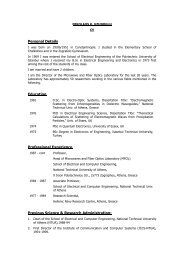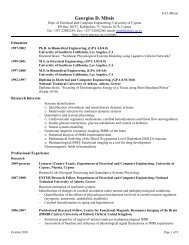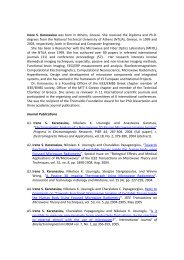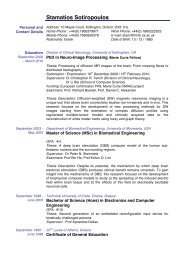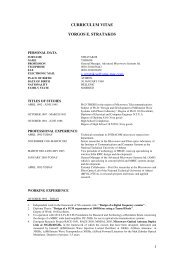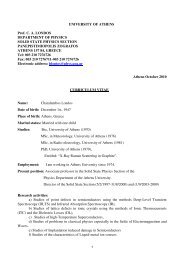Development and testing of a 10 GHz phased-array cylindrical ...
Development and testing of a 10 GHz phased-array cylindrical ...
Development and testing of a 10 GHz phased-array cylindrical ...
Create successful ePaper yourself
Turn your PDF publications into a flip-book with our unique Google optimized e-Paper software.
<strong>Development</strong> <strong>and</strong> Testing <strong>of</strong> a <strong>10</strong> <strong>GHz</strong><br />
Phased-Array Cylindrical-Antenna<br />
Transmitting System Incorporating a<br />
Least-Squares Radiation-Pattern<br />
Synthesis Technique<br />
Nikolaos c. Athanasopoulos 1 , Konstantinos A. Mourlzoukos 1 , Giorgos E. Stratakos 2 ,<br />
Rodoula J. Makri 1 , <strong>and</strong> Nikolaos K. Uzunoglu 1<br />
1Microwaves & Fiber Optics Laboratory, School <strong>of</strong> Electrical & Computers Engineers<br />
National Technical University <strong>of</strong> Athens<br />
9 Iroon Polytechniou Str. 15773 Zografou, Athens, Greece<br />
Tel: +302<strong>10</strong>7722289; Fax: +302<strong>10</strong>7722291;<br />
E-mail: nathan@esd.ece.ntua.gr.mourtzoukosk@gmail.com. rodia@esd.ece.ntua.gr, nuzu@cc.ece.ntua.gr<br />
2Advanced Microwave Systems Ltd, 2<br />
25th Martiou Str. 1778 Tauros, Athens, Greece<br />
Tel: +30 2<strong>10</strong>4838442; E-mail: y.stratakos@ams-mw.com,<br />
Abstract<br />
This research presents the development <strong>and</strong> <strong>testing</strong> procedures for an experimental <strong>phased</strong>-<strong>array</strong> <strong>cylindrical</strong>-antenna<br />
transmitting system, operating at <strong>10</strong> <strong>GHz</strong>. The antenna-element excitation phases are set at the intermediate-frequency<br />
stage, <strong>and</strong> are determined by using a least-squares radiation-pattern synthesis technique. The antenna-element excitation<br />
amplitudes are taken to be equal <strong>and</strong> fixed. The system provides steerable main lobes <strong>and</strong> nulls at predefined directions,<br />
including control <strong>of</strong> the sidelobes at specified levels. It can be used for communications <strong>and</strong> radar applications with<br />
interference-rejection requirements.<br />
Keywords: Phased <strong>array</strong>s; <strong>cylindrical</strong> <strong>array</strong>s; least squares methods; antenna radiation patterns; pattern synthesis; beam<br />
steering; <strong>array</strong> signal processing<br />
T he<br />
1. Introduction<br />
idea <strong>of</strong> developing antenna <strong>array</strong> systems with electronically<br />
controlled beams was proposed as early as the 1940s [1<br />
4]. In the last three decades, with the advances in MMIC technology,<br />
<strong>phased</strong>-<strong>array</strong> systems have started to become feasible at a reasonable<br />
cost. This is illustrated by the many solid-state active<br />
<strong>array</strong>s that use MMIC technology that have been deployed or are<br />
under development [5]. The use <strong>of</strong> <strong>phased</strong>-<strong>array</strong> technologies provides<br />
significant benefits compared with conventional mechanically<br />
steered antennas, such as fast searching <strong>of</strong> a given field <strong>of</strong><br />
view, interference-suppression capability, <strong>and</strong> flexible control <strong>of</strong><br />
radiation patterns [6]. Typical <strong>phased</strong> <strong>array</strong>s make use <strong>of</strong> large<br />
numbers <strong>of</strong>elements (several hundred), <strong>and</strong> usually suffer interference.<br />
This condition does not hold true for the case <strong>of</strong>small <strong>phased</strong><br />
<strong>array</strong>s, such as might be used in communication <strong>and</strong> radar applications.<br />
In some antenna applications, planar <strong>array</strong>s have limitations<br />
imposed primarily by the need for introducing an aerodynamic<br />
radome. If <strong>array</strong> elements are allocated over a confonnal surface,<br />
those limitations may ease. Cylindrical <strong>array</strong>s - the most common<br />
type <strong>of</strong> confonnal <strong>array</strong>s - find applications in situations where<br />
wide scanning angles in azimuth are needed, exploiting their azimuthal<br />
symmetry [7]. This benefit has found applications in broadcast<br />
antennas <strong>and</strong> direction-finding antenna systems [8].<br />
This work presents the development <strong>of</strong> a small <strong>phased</strong>-<strong>array</strong><br />
transmitting system <strong>of</strong> <strong>cylindrical</strong> geometry. Since the literature<br />
lacks small <strong>cylindrical</strong> <strong>phased</strong> <strong>array</strong>s, the proposed system can be<br />
considered as a demonstrator. It can be used in short-range communication<br />
<strong>and</strong> radar applications.<br />
In most practical <strong>phased</strong>-<strong>array</strong> systems, RF beamfonning is<br />
implemented with both amplitude <strong>and</strong> phase control <strong>of</strong> the excita-<br />
80 ISSN <strong>10</strong>45-9243120081$25 ©2008 IEEE IEEE Antennas <strong>and</strong> Propagation Magazine, Vol. 50, No.6, December 2008
tion currents. In this work, beamforming is implemented at the<br />
intermediate-frequency (IF) stage with phase-only control, providing<br />
a faster <strong>and</strong> less complicated approach for beam steering <strong>and</strong><br />
interference rejection. Nevertheless, IF processing introduces phase<br />
unbalance among RF emitted signals, <strong>and</strong> this must be compensated<br />
for.<br />
In Section 2, the development <strong>of</strong> the experimental <strong>phased</strong><br />
<strong>array</strong> is presented. The antenna <strong>array</strong> <strong>and</strong> the IF <strong>and</strong> RF units are<br />
given in detail. In Section 3, the radiation-pattern-synthesis method<br />
used is given. It is based on a least-squares technique adapted to<br />
the system's architecture. In Section 4, excitation amplitudes are<br />
adjusted <strong>and</strong> the phase unbalance among RF emitted signals is<br />
compensated for. Finally, in Section 5, radiation-pattern measurements<br />
are presented for five beamforming scenarios, <strong>and</strong> these are _<br />
l----~----~-----------:-~~j~~-----~----------~-----][~~~~~~~;~~~~-] -~~~;~:~~~]<br />
, I I I<br />
I I I I<br />
: : : e1.#-<strong>10</strong> :<br />
I I,<br />
I<br />
I : TxRx#-5 e1.#-9! I<br />
~------ -- --- --- -------------- -------- ---- ~ :--------------- ------<br />
compared with simulated results. The <strong>cylindrical</strong> <strong>array</strong> gain is cal- Figure 2. A conceptual model <strong>of</strong> the experimental <strong>phased</strong>-<strong>array</strong><br />
culated with the application <strong>of</strong>the Friis transmission equation. antenna system.<br />
2. The Phased-Array<br />
Cylindrical Antenna System<br />
The experimental <strong>phased</strong>-<strong>array</strong> antenna system is presented in<br />
Figure 1. As depicted in the conceptual model <strong>of</strong> Figure 2, the<br />
system was developed in three basic units: the beamforming unit,<br />
the transceivers unit, <strong>and</strong> the antenna-<strong>array</strong> unit. The intermediate-frequency<br />
input signal is divided into 11 individual IF signals<br />
that are phase adjusted through the beamforming unit. These 11 IF<br />
phase-adjusted signals are driven in parallel to the 11 transmitter<br />
modules (numbered Tx-5 to Tx5) <strong>of</strong> the transceivers unit, they<br />
follow up-conversion <strong>and</strong> amplification procedures, <strong>and</strong> finally<br />
they are emitted by the 21-element (numbered from element -<strong>10</strong> to<br />
element <strong>10</strong>) antenna-<strong>array</strong> unit at the <strong>10</strong> <strong>GHz</strong> frequency region.<br />
Each pair <strong>of</strong>adjacent radiators is fed by the same transmitter module,<br />
with the exception <strong>of</strong> the central module (element 0), which is<br />
driven alone by the TxO module. In the subsections that follow, the<br />
individual units <strong>of</strong>the system are described.<br />
2.1 The Antenna-Array Unit<br />
The antenna-<strong>array</strong> unit, originally designed in the framework<br />
<strong>of</strong> the Western European Armament Group (WEAG)-THALES<br />
JP1.03-WEAG program [9-11], is a conformal <strong>array</strong> antenna con-<br />
Figure 3. The antenna-<strong>array</strong> unit.<br />
el.#-2<br />
el.#-1<br />
e1.#O<br />
e1.# 1<br />
e1.#2<br />
Figure 4. A pair <strong>of</strong> adjacent radiating elements.<br />
el.#9<br />
el.#<strong>10</strong><br />
Ground<br />
plane<br />
sisting <strong>of</strong>a series <strong>of</strong>21 microstrip-patch elements. It is printed on a<br />
dielectric substrate <strong>of</strong> Teflon R04003 (G r = 3.38, tan l5 = 0.0018,<br />
thickness 0.51 mm). The whole structure is mounted on a <strong>cylindrical</strong><br />
aluminum surface (with a radius <strong>of</strong> curvature <strong>of</strong> 0.5 m). The<br />
antenna-<strong>array</strong> unit is presented in Figure 3.<br />
The 21 microstrip elements are <strong>of</strong> rectangular shape, with<br />
dimensions L = 7 mm <strong>and</strong> W = 11 mm. The center-to-center spacing<br />
between adjacent radiators is 0.66...1, (where A is the free-space<br />
wavelength at the <strong>10</strong> <strong>GHz</strong> operating frequency), which corresponds<br />
to a 2.25° angular spacing. Each individual radiator is fed through<br />
a coaxial probe, which runs through the aluminum surface <strong>and</strong> the<br />
dielectric substrate, <strong>and</strong> finally touches the surface <strong>of</strong> the element.<br />
Figure 4 presents a pair <strong>of</strong>adjacent radiators. The return loss at the<br />
input <strong>of</strong> each radiator is, on average, -15 dB. The mutual coupling<br />
Figure 1. The experimental <strong>phased</strong>-<strong>array</strong> antenna system. between adjacent radiators when they are excited in-phase is, on<br />
fel::l:: Antennas ana propagation Magazine, Vol. 50, No.6, December 2008 81<br />
I<br />
I
average, -24 dB; for the nonadjacent radiators, this value is significantly<br />
reduced.<br />
2.2 The Transceivers Unit<br />
The transceivers unit consists <strong>of</strong> 11 modules. After being<br />
phase adjusted through the beamforming unit, the 11 IF signals are<br />
introduced in parallel to the transmitting chains <strong>of</strong> the modules at<br />
140 MHz. After being filtered <strong>and</strong> up-converted at 1 <strong>GHz</strong>, they<br />
pass through the appropriate filters <strong>and</strong> are then amplified. The<br />
final up-conversion is at <strong>10</strong> <strong>GHz</strong>, where the signals are filtered <strong>and</strong><br />
amplified. Each one <strong>of</strong> the <strong>10</strong> <strong>GHz</strong> amplified signals is divided by<br />
a power splitter, <strong>and</strong> drives two adjacent radiators <strong>of</strong> the 21-element<br />
antenna <strong>array</strong>_ This means that each module drives two adjacent<br />
radiators, with the exception <strong>of</strong> the central radiator (element<br />
0), setting the reference phase <strong>of</strong> the system. This reference element<br />
is driven by a single module (TxO), as is depicted in the conceptual<br />
model <strong>of</strong> Figure 2. A picture <strong>of</strong> a transceiver module is<br />
shown in Figure 5.<br />
2.3 The Beamforming Unit<br />
The beamforming unit is implemented at the IF stage. In a<br />
personal computer (PC), the operator sets the system's operation<br />
mode (scanning or non-scanning), defines the number <strong>of</strong> active<br />
radiators <strong>of</strong> the 21-element <strong>array</strong> antenna, <strong>and</strong> finally specifies the<br />
desired radiation-pattern characteristics, i.e., the main-lobe <strong>and</strong> null<br />
directions. The operator's environment is presented in Figure 6.<br />
The radiation-pattern specifications that the operator defines<br />
are used to compute the appropriate phase-shift values that must be<br />
set for the 11 IF signals. For that purpose, a least-squares method is<br />
implemented, <strong>and</strong> it will be presented analytically in the next section.<br />
These values are transferred in digital form through an RS232<br />
serial interface to the control subunit, where they are organized in<br />
12-bit digital sequences while the appropriate control <strong>and</strong> synchronization<br />
signals are generated. The 12-bit digital sequences are<br />
driven to the digital-to-analog (D-to-A) conversion subunit. There,<br />
under the guidance <strong>of</strong>control <strong>and</strong> synchronization signals, they are<br />
converted to analog voltages in the range <strong>of</strong> 0-12 V. These analog<br />
Figure 5. A transceiver module <strong>of</strong> the transceivers unit.<br />
~~~:~.~~·;iC u .<br />
,~;;..~", No"-al~;:; q, ;,:~ rif~:-,',:~,',:,;'~~,'r><br />
,-.,;;;~.................·:i; :.":'''' :':/11'<br />
.111 _... ..... ;"=·~:;·r::~<br />
";<strong>of</strong>~ S;i..~f~: ;;;~~~1J-"----<br />
:[:~21<br />
.};~:4t ~.~);: il;l.il \f~;:· ;;,:: ~;. ;~iHEHW<br />
/'1 I ~t~>-, l": 'r, P':\"T<br />
~~~<br />
):;"'i~~ ~ 3J~/~'" /'::t 11,,/:)<br />
Figure 6. The operator environment.<br />
Figure 7. The phase-shifting subunit.<br />
• .• ~ ;:"X~.~<br />
:.. '.;.;::....:;:::'<br />
'I ~:~~~~ :~:~~;=:~sed el96008N1 ~·i;.i:·.':':<br />
~,:;.,;.i'j<br />
voltages are finally driven to the phase-shifting subunit, presented<br />
in Figure 7. It consists <strong>of</strong> 11 channels, one for each IF signal. Two<br />
phase shifters, controlled by the analog voltages in the range <strong>of</strong> 0<br />
12 V, are connected in series at each IF channel. This covers a total<br />
range <strong>of</strong> -180 0 ~ 180 0 , <strong>and</strong> sets the appropriate phase shift for<br />
each IF path.<br />
3. Phase-Computation <strong>and</strong><br />
Radiation-Pattern Synthesis Technique<br />
The power intensity at the azimuth plane <strong>of</strong> this 21-element<br />
<strong>cylindrical</strong> <strong>array</strong> is expressed in the form [12]<br />
U(¢)=BI:~:f(¢-n~¢)la21<br />
eXP{J 2:R [cos(¢-n~¢)J-La2t (1)<br />
B is a normalization constant, ~t/J is the angular distance between<br />
adjacent elements, R is the radius <strong>of</strong> the cylinder, <strong>and</strong> A is the<br />
wavelength at the frequency <strong>of</strong> operation. In order to achieve a<br />
desired radiation pattern, the nth radiator's phase excitation, La~,<br />
must be appropriately set. In Equation (1), f(t/J-n~t/J) is the<br />
82 IEEE Antennas <strong>and</strong> Propagation Magazine, Vol. 50, No.6, December 2008
antenna-element pattern, which, for the rectangular microstrip<br />
patch element, is given approximately by [13]<br />
f(¢ -nl1¢) = Ccos(¢-nl1¢)<br />
. [kh cos(¢ - nl1¢)] . [kL sin(¢ - nl1¢)]<br />
SIn SIn<br />
2 2<br />
khcos(¢-nl1¢) kLsin(¢-nl1¢)<br />
2 2<br />
(2)<br />
C is a normalization constant, h is the dielectric substrate thickness,<br />
L is the microstrip radiator's length, <strong>and</strong> k is the wavelength<br />
number.<br />
A least-squares radiation pattern-synthesis technique [14] is<br />
implemented for the appropriate phase computation. According to<br />
this, assume a required power-intensity pattern mask, M (¢), the<br />
shape <strong>of</strong> which is specified based upon the requirements <strong>of</strong> the<br />
main-lobe orientation, the null angles, <strong>and</strong> the sidelobe levels.<br />
Then, a vector <strong>of</strong>phase excitations,<br />
is computed. This will produce a normalized power-intensity pattern,<br />
U0 (¢), in a such way as to minimize the discretized mean-<br />
square difference:<br />
n 2<br />
e 2 = Lluo(l1Jj,(W))-M (l1Jj)1 '<br />
;=1<br />
with n sufficiently large. According to the system architecture, the<br />
excitation phases must be equal for every two adjacent radiators,<br />
with the exception <strong>of</strong> the central radiator. In other words, the following<br />
constraint must be satisfied:<br />
o 0<br />
La-IO = La_9,<br />
The power-intensity pattern-mask function used is described by the<br />
following equation:<br />
¢o is the desired orientation <strong>of</strong> the main beam, <strong>and</strong> ¢I is the<br />
desired position <strong>of</strong> the null. G is the desired null depth, while D is<br />
the desired sidelobe level. l1¢o <strong>and</strong> 11¢I set the width <strong>of</strong> the main<br />
bean <strong>and</strong> null, respectively.<br />
O,¢ E [¢O - t!,.¢o ~ ¢ ~ ¢o + l1¢ol)<br />
M(¢) = G,l1J E [¢I -11¢I ~ ¢ ~ ¢I + 11¢I] .<br />
{<br />
D,¢ E elsewhere<br />
This radiation-pattern synthesis technique <strong>and</strong> the computation<br />
<strong>of</strong> the excitation phases for the corresponding beamforming<br />
scenarios were executed using MathCAD 9 s<strong>of</strong>tware.<br />
(4)<br />
(5)<br />
(6)<br />
4. Calibration Procedures<br />
4.1 Amplitude Adjustments<br />
The beamforming unit computes <strong>and</strong> controls only the phases<br />
<strong>of</strong> the excitation currents to achieve the desired radiation patterns.<br />
This presupposes that amplitudes should be constant. As can be<br />
seen from Figure 8, amplitude variations do not exceed ±0.75 dB<br />
around 11.75 dBm, <strong>and</strong>, as a result, they can be considered to be<br />
constant.<br />
4.2 Phase Calibration<br />
In each transmission channel, the 140 MHz input signal goes<br />
through power divisions, amplifications, <strong>and</strong> up-conversions, as<br />
well as suffering from different cable lengths. All these unavoidable<br />
factors introduce phase <strong>of</strong>fsets among the 21 signals that are<br />
finally emitted at the <strong>10</strong> <strong>GHz</strong> region. This phase <strong>of</strong>fset must be<br />
measured <strong>and</strong> taken into account in the beamforming procedure, so<br />
that the signals have their phase adjusted correctly.<br />
Phase calibration is implemented by the use <strong>of</strong> a "Magic T."<br />
Based on the basic properties <strong>of</strong> the Magic T [15], when two inphase<br />
signals are inserted into Ports 3 <strong>and</strong> 4, respectively, the<br />
Port 1 output signal is maximized. Simultaneously, the Port 2 output<br />
signal is minimized. The system's phase reference (the output<br />
<strong>of</strong>TxO) is connected to Port 3. The Port 1 output drives a spectrum<br />
analyzer, <strong>and</strong> Port 2 is terminated. The outputs <strong>of</strong>the rest <strong>of</strong>the <strong>10</strong><br />
transmitter modules are routed successively to Port 4. For each <strong>of</strong><br />
them, the control voltages <strong>of</strong> the corresponding phase shifters are<br />
manually progressively changed until the power in the spectrum<br />
analyzer becomes maximum. Port I is then terminated <strong>and</strong> Port 2<br />
is input to the spectrum analyzer. If the value is minimum, the two<br />
signals in Ports 3 <strong>and</strong> 4 are in-phase. Analog voltages are translated<br />
to the corresponding phase values, <strong>and</strong> the phase <strong>of</strong>fsets between<br />
the system's reference <strong>and</strong> each <strong>of</strong>the inputs <strong>of</strong>the rest <strong>of</strong>radiating<br />
elements are calculated. The measured phase <strong>of</strong>fset is presented in<br />
Figure 9. It was observed that the phase <strong>of</strong>fset was the same for<br />
every two adjacent radiators. This was due to the fact they were<br />
driven by the same transmitter module.<br />
E l-------tatr---+-~~_+_---llto.............-.4~~--~<br />
en ~ l----~/!---4--+-~H-_t_-------T---<br />
CD<br />
"C<br />
.a ~-----~---lL....--~H-t----------'t-------<br />
=a:<br />
E~<br />
, -._..,-~-~~~ ·_· ·1~·~ · · · ·· ··..· ·..·· _.__ -:<br />
« J...------+-+-~_4+1t+--------~T:;~<br />
-<strong>10</strong> -9 -8 -7 -6 -5 -4 -3 -2 -1 0 1 2 3 4 5 6 7 8 9 <strong>10</strong><br />
Number <strong>of</strong> antenna element<br />
Figure 8. The amplitudes <strong>of</strong> the signals at the inputs <strong>of</strong> the 21<br />
radiators.<br />
IEEE Antennas <strong>and</strong> Propagation Magazine, Vol. 50, No.6, December 2008 83
-~---"-_.._._-_._--_ _ !t..,.._ _ _.---'---'---"---' ;<br />
·8 ·7 -6 -5 -4 -3 ·2 -1<br />
.........•..._..&..0# _ , _ _.- _ _ .......--.<br />
Number <strong>of</strong> radiator<br />
Figure 9. The phase <strong>of</strong>fset between <strong>10</strong> <strong>GHz</strong> signals at the<br />
inputs <strong>of</strong> the radiators <strong>and</strong> the system's reference.<br />
5. Radiation Measurements<br />
5.1 Radiation Patterns<br />
The phase excitations <strong>of</strong> the 21 signals that drive the <strong>array</strong><br />
antenna, <strong>and</strong> that are calculated following the least-squares synthesis<br />
technique, are the sum <strong>of</strong>two factors:<br />
T T T<br />
W = WADJ +W CAL '<br />
WIDJ is the vector <strong>of</strong> phases that must be adjusted by the beam<br />
forming unit, <strong>and</strong> WtAL is the vector <strong>of</strong> the measured phase <strong>of</strong>fset<br />
that is provided by Figure 9. The phases that must be set by the<br />
beamforming unit are then given by<br />
T T T<br />
WADJ = W - WCAL .<br />
The <strong>phased</strong>-<strong>array</strong> transmitting system that was developed was<br />
tested through several beamforming scenarios. An X-b<strong>and</strong> hom<br />
antenna (20 dB gain), with its output going into a spectrum analyzer,<br />
was used as a receiver. The distance between the transmitting<br />
system <strong>and</strong> the receiver was 15.5 m, satisfying the far-field<br />
condition. In the following, azimuth-plane radiation-pattern measurements<br />
are presented for five beamfonning scenarios, <strong>and</strong> are<br />
compared with simulated patterns. In the diagrams, the red lines<br />
correspond to the measurements, whereas the blue lines correspond<br />
to the simulation. For each scenario examined, the calculated phase<br />
excitations, W T , are given in the corresponding tables (Tables 1 to<br />
5).<br />
Table 1. The calculated antenna-element excitation phases with<br />
the main lobe at 0° <strong>and</strong> SLLs < -20 dB.<br />
84<br />
# <strong>of</strong>Radiator W # <strong>of</strong>Radiator W<br />
(7)<br />
(8)<br />
-<strong>10</strong> -4.469° 1 -12.319°<br />
-9 -4.469° 2 -12.319°<br />
-8 139.812° 3 -47.957°<br />
-7 139.812° 4 -47.957°<br />
-6 -115.279° 5 -116.081°<br />
-5 -115.279° 6 -116.081°<br />
-4 -47.154° 7 140.042°<br />
-3 -47.154° 8 140.042°<br />
-2 -11.975° 9 -2.578°<br />
-1 -11.975° <strong>10</strong> -2.578°<br />
0 0° - -<br />
Table 2. The calculated antenna-element excitation phases with<br />
the main lobe at <strong>10</strong>°, SLLs < -20 dB.<br />
# <strong>of</strong> Radiator W # <strong>of</strong> Radiator W<br />
-<strong>10</strong> -51.<strong>10</strong>8° 1 39.591°<br />
-9 -51.<strong>10</strong>8° 2 39.591 °<br />
-8 178.018° 3 78.839°<br />
-7 178.018° 4 78.839°<br />
-6 9.339° 5 85.027°<br />
-5 9.339° 6 85.027°<br />
-4 168.564° 7 50.535°<br />
-3 168.564° 8 50.535°<br />
-2 -68.64° 9 -20.512°<br />
-1 -68.64° <strong>10</strong> -20.512°<br />
0 0° - -<br />
Table 3. The calculated antenna-element excitation phases with<br />
the main lobe at 20°, SLLs < -20 dB.<br />
# <strong>of</strong> Radiator W # <strong>of</strong>Radiator W<br />
-<strong>10</strong> -64.973° 1 <strong>10</strong>3.773°<br />
-9 -64.973° 2 <strong>10</strong>3.773°<br />
-8 -116.425° 3 -144.385°<br />
-7 -116.425° 4 -144.385°<br />
-6 158.892° 5 -62.395°<br />
-5 158.892° 6 -62.395°<br />
-4 35.924° 7 -15.355°<br />
-3 35.924° 8 -15.355°<br />
-2 -122.498° 9 5.099°<br />
-1 -122.498° <strong>10</strong> 5.099°<br />
0 0° - -<br />
Table 4. The calculated antenna-element excitation phases with<br />
the main lobe at 0°, a null at 20°, SLLs < -20 dB.<br />
# <strong>of</strong>Radiator W # <strong>of</strong>Radiator W<br />
-<strong>10</strong> -45.149° 1 -19.022°<br />
-9 -45.149° 2 -19.022°<br />
-8 <strong>10</strong>7.497° 3 -44.863°<br />
-7 <strong>10</strong>7.497° 4 -44.863°<br />
-6 -140.661° 5 -132.582°<br />
-5 -140.661° 6 -132.582°<br />
-4 -70.932° 7 140.443°<br />
-3 -70.932° 8 140.443°<br />
-2 -19.423° 9 -6.875°<br />
-1 -19.423° <strong>10</strong> --6.875°<br />
0 0° - -<br />
IEEE Antennas <strong>and</strong> Propagation Magazine, Vol. SO, No.6, December 2008
- 0 -25 -20 -15 -<strong>10</strong><br />
ph( degrees)<br />
<strong>10</strong> 15 20 25 3<br />
ccl-------.,~---J.-+-::-Hr-+--~~----:~------t<br />
~ :::>1--------."J---~+_____::_9A__+_--_T_J~--_\_--7'i<br />
Figure <strong>10</strong>. The main io6e at Oo~<br />
iii'<br />
~~--'--~~~:""'---~i-+-----+-A-+-+-~----:::!i~<br />
::>~:I:::::...--~,------.::w:~------';~-+--I-----i<br />
phi (degrees)<br />
mJ-----P:---f.S--\---~Ir4_--__4_I~_l_----~<br />
~<br />
::>I-----~+----lt~__+_~~--_+_~_;_----_i<br />
phi (degees)<br />
Figure 12. The main lobe at 20°.<br />
phi (degrees)<br />
Figure 11. The main lobe at <strong>10</strong>°.<br />
-25 -20 -15 -<strong>10</strong> -5<br />
15 18 21 24 27 3D<br />
in L...J.,.--------...-2QL.+----~t:=::~--_____1<br />
"'0<br />
......" 1---~-___J~~--=~ri5-+-----+_-_::__-____j<br />
-----_._--~~---phi<br />
(degrees)<br />
Figure 13. The main lobe at 0° degrees with a null at 20°. Figure 14. The main lobe at <strong>10</strong>° with a null at 16°.<br />
IEEE Antennas <strong>and</strong> Propagation Magazine, Vol. 50, No.6, December 2008 85
Table 5. The calculated antenna-element excitation phases with<br />
the main lobe at <strong>10</strong>°, a null at 16°, SLLs < -15 dB.<br />
# <strong>of</strong> Radiator W # <strong>of</strong> Radiator W<br />
-<strong>10</strong> -53.113° 1 50.821 °<br />
-9 -53.113° 2 50.821°<br />
-8 145.589° 3 99.981 °<br />
-7 145.589° 4 99.981 °<br />
-6 -19.652° 5 <strong>10</strong>6.284°<br />
-5 -19.652° 6 <strong>10</strong>6.284°<br />
-4 152.006° 7 63.369°<br />
-3 152.006° 8 63.369°<br />
-2 -75.401 ° 9 -18.449°<br />
-1 -75.401° <strong>10</strong> -18.449°<br />
0 0° - -<br />
5.1.1 Main Lobe at 0°, SLLs < -20 dB<br />
The calculated phase excitations for this case are given in<br />
Table 1. It was observed from Figure <strong>10</strong> that the measured pattern<br />
had its maximum in the frontal direction. The sidelobe levels<br />
(SLLs) varied below -15 dB, while the specified levels, having<br />
been fulfilled by the simulated pattern, were -20 dB.<br />
5.1.2 Main Lobe at <strong>10</strong>°, SLLs < -20 dB<br />
The calculated phase excitations for this case are given in<br />
Table 2. Figure 11 shows that the main lobe was steered at <strong>10</strong>°.<br />
Two sidelobes were at about -<strong>10</strong> dB, while the rest <strong>of</strong>the sidelobes<br />
varied around -15 dB. The specified sidelobe levels, having been<br />
fulfilled by the simulated pattern, were -20 dB.<br />
5.1.3 Main Lobe at 20°, SLLs < -20 dB<br />
The calculated phase excitations for this case are given in<br />
Table 3. The main lobe was focused at 20°, as Figure 12 depicts.<br />
The sidelobes varied around -15 dB, while the specified levels<br />
were -20 dB. In the region around -20°, a sidelobe with a level <strong>of</strong><br />
-5 dB appeared, as the simulation predicted.<br />
5.1.4 Main lobe at 0°, Null at 20°,<br />
SLLs < -20 dB<br />
The calculated phase excitations for this case are given in<br />
Table 4. Figure 13 shows that the main lobe was focused on the<br />
frontal direction. A null was placed at 20°, as asked. Its depth was<br />
about -28 dB, while the specified value, having been fulfilled by<br />
the simulated pattern, was -50 dB. The sidelobes varied around the<br />
-15 dB level, while the specified levels, having been fulfilled by<br />
the simulated pattern, were -20 dB.<br />
86<br />
5.1.5 Main lobe at <strong>10</strong>°, Null at 16°,<br />
SLLs < -15 dB<br />
The calculated phase excitations for this case are given in<br />
Table 5. It was observed from Figure 14 that the main lobe was<br />
steered to <strong>10</strong>°, <strong>and</strong> a null was placed at the requested position, 16°.<br />
Its depth was about -21 dB, while the specification, having been<br />
fulfilled by the simulated pattern, was -20 dB. The sidelobes varied<br />
around -15 dB, as was specified <strong>and</strong> was fulfilled by the simulated<br />
pattern.<br />
5.2 Gain Calculation<br />
The gain <strong>of</strong> this 21-element <strong>cylindrical</strong> <strong>array</strong> was computed<br />
using the Friis transmission equation. According to that equation,<br />
the received power that is measured in the spectrum analyzer is<br />
given by [19]<br />
P,. =GARRAr GHORN~ (l-IrARRAl)(l-IrHORN 1 2 )<br />
(4~S )\Vt • PHORNIL. (9)<br />
The gain <strong>of</strong>the <strong>array</strong> in dB is then given by<br />
[ n=lO ( 2)]<br />
(GARRAr)dB=(P")dBm-lOlog n~o~nX l-Irt.l<br />
-lOIOg(l-IrHORNn-(GHORN )dB - 20<strong>10</strong>g( 4~S)<br />
-IOlog(lpt· PHORN/)-(L)dB (<strong>10</strong>)<br />
The power received, p,., in the spectrum analyzer was measured as<br />
-20 dBm. F;n (n = -<strong>10</strong>,...,<strong>10</strong>) is the power that was fed to the 21<br />
radiators <strong>and</strong> arises from Figure 8. r t (n =-<strong>10</strong>,...,<strong>10</strong>) is the<br />
n<br />
return loss at the input <strong>of</strong> each radiator, which, as was already<br />
mentioned in Section 2.1, was -15 dB. r HORN is the return loss at<br />
the input <strong>of</strong> the hom antenna, which was -8 dB, while, as has<br />
already be~n mentioned, the hom antenna's gain was 20 dB. The<br />
free-space losses for the distance 8 = 15.5 m <strong>and</strong> for A = 3cm are<br />
20 <strong>10</strong>g(~) = -76.25 dB.<br />
41£8<br />
(11)<br />
During measurements, it was observed that there were no crosspolarization<br />
phenomena between the 21-element <strong>cylindrical</strong> <strong>array</strong><br />
<strong>and</strong> the hom antenna. As a result <strong>of</strong> that, the factor Ipt· PHORNI<br />
could be ignored in Equation (<strong>10</strong>). Finally, in Equation (<strong>10</strong>) the<br />
factor L represents the losses <strong>of</strong> the coaxial cable that carries the<br />
received signal from the hom antenna to the spectrum analyzer.<br />
These losses were measured as being -3 dB.<br />
Taking into account all the factors involved in Equation (<strong>10</strong>),<br />
the 21-element <strong>cylindrical</strong> <strong>array</strong> gain can be computed as<br />
IEEE Antennas <strong>and</strong> Propagation Magazine, Vol. 50, No.6, December 2008
(GARRAy);;LINDRlCAL = 14.25 dB.<br />
Assuming now that these 21 radiators were allocated over a planar<br />
surface, the maximum planar <strong>array</strong> gain would ideally be 21 times<br />
the element gain [1 7]. The element gain was measured to be<br />
5.5 dBi, so for this ideal planar-<strong>array</strong> model, the gain would be<br />
PLANAR ()<br />
( GARRAy ) dB =lOlog 21 +5.5=18.72dB.<br />
(12)<br />
(13)<br />
Equation (13), which gives the gain for the planar <strong>array</strong>, is<br />
ideal. If a realistic planar <strong>array</strong> was tested by application <strong>of</strong> the<br />
Friis transmission formula, the <strong>array</strong> gain would be lower than the<br />
ideal value <strong>of</strong> 18.72 dB (Equation (13)). A quantitative comparison<br />
<strong>of</strong> the planar <strong>and</strong> <strong>cylindrical</strong> <strong>array</strong> gain would make sense only if<br />
both <strong>array</strong>s were measured with the same method, <strong>and</strong> the Friis<br />
transmission formula was applied. The purpose <strong>of</strong> the reference to<br />
the planar case in the framework <strong>of</strong>this paper is only qualitative, in<br />
order to show that the radiators that approach the edges <strong>of</strong>the <strong>array</strong><br />
contribute less than the element's maximum power towards the<br />
<strong>array</strong>'s frontal direction.<br />
Finally, from the patterns <strong>of</strong>Figures <strong>10</strong>-12, it can be observed<br />
that the -3 dB beamwidth was 5°, staying constant as the main<br />
beam scanned. Consequently, the <strong>cylindrical</strong>-antenna gain did not<br />
fluctuate within the -20° ~ 20° scanning area.<br />
5.3 Discussion<br />
The measured radiation patterns proved that this <strong>cylindrical</strong><br />
<strong>phased</strong>-<strong>array</strong> antenna system provides steerable main beams at prespecified<br />
~irections, <strong>and</strong> nulls at desired positions, <strong>of</strong> the azimuth<br />
plane. The IF phase control, applying a least-squares pattern-synthesis<br />
technique in combination with phase calibration, gave accurate<br />
results in terms <strong>of</strong>the main-beam <strong>and</strong> null positions. This was<br />
shown by the good agreement between measurements <strong>and</strong> simulations.<br />
On the other h<strong>and</strong>, it was observed that the sidelobe levels<br />
were substantially higher than the desired specifications, about<br />
5 dB to <strong>10</strong> dB above the specifications. The small variation in the<br />
amplitudes <strong>of</strong> the emitted signals (as presented in Figure 8), may<br />
have been a possible reason for this. The mutual coupling among<br />
the radiating elements, which varied as the phase excitations<br />
changed, may also have affected the radiation characteristics in<br />
terms <strong>of</strong>the sidelobe levels.<br />
As mentioned in the introduction, <strong>cylindrical</strong> <strong>array</strong>s find<br />
application in situations where wide scanning angles in azimuth are<br />
needed, exploiting their azimuthal symmetry. In this research, as<br />
the inter-element angular spacing was 2.25°, the 21-element <strong>array</strong><br />
covered a 45° arc <strong>of</strong> the <strong>cylindrical</strong> surface, illuminating only a<br />
sector <strong>of</strong> the azimuthal plane. For the total azimuthal illumination,<br />
eight such 21-element <strong>array</strong>s could be successively allocated on the<br />
<strong>cylindrical</strong> surface, <strong>and</strong> they would create a full ring <strong>array</strong>, which<br />
could be fed by the proposed system. An appropriate commutation<br />
network, that could be incorporated into the RF stage <strong>of</strong> the system,<br />
would feed one 21-element sub<strong>array</strong> each time, illuminating<br />
the corresponding azimuthal sector while the seven remaining 21element<br />
sub<strong>array</strong>s stayed inactive.<br />
IEEE Antennas <strong>and</strong> Propagation MagaZine, Vol. 50, No.6, December 2008<br />
6. Conclusions<br />
The development <strong>of</strong> a <strong>10</strong> <strong>GHz</strong> <strong>cylindrical</strong>-<strong>array</strong> antenna<br />
transmitting system was presented in this study. The system was<br />
measured <strong>and</strong> tested, <strong>and</strong> the radiation patterns achieved were<br />
compared with the simulated patterns. Good agreement in the<br />
comparison showed that the use <strong>of</strong>IF beamforming proved to be an<br />
approach providing stability <strong>and</strong> easy control <strong>of</strong> the radiation patterns.<br />
The system provides radiation patterns with steerable main<br />
lobes, <strong>and</strong> nulls at prespecified positions within the azimuthal<br />
region <strong>of</strong> -20° ~ 20° . The scanning speed <strong>of</strong>the system is 8 JLs. It<br />
can be used in radar <strong>and</strong> communication applications with interference-rejection<br />
requirements. Additionally, its basic properties can<br />
be applied in MIMO communication systems [18, 19]. A MIMO<br />
system has multiple antenna elements at both the transmitter <strong>and</strong><br />
receiver. Those multiple antennas can be used for the transmission<br />
<strong>of</strong> several parallel data streams to increase the capacity <strong>of</strong> the system.<br />
This presupposes the ability to control the excitation <strong>of</strong> the<br />
multiple antennas for both the transmitter <strong>and</strong> the receiver. The<br />
<strong>phased</strong> controlled system that was presented in this research gives<br />
the ability to apply such technology towards confronting non-desirable<br />
effects caused by multipath propagation. Finally, the possibility<br />
<strong>of</strong>using the developed conformal <strong>array</strong> as a focal-plane radiator<br />
in a large reflector antenna is an interesting application that is also<br />
being considered.<br />
7. References<br />
1. M. I. Skolnik, "Survey <strong>of</strong> Phased Array Accomplishments <strong>and</strong><br />
Requirements for Navy Ships," Phased Array Antennas, Norwood,<br />
MA, Artech House Inc., 1972, pp. 15-20.<br />
2. L. N. Ridenour, Radar System Engineering, New York,<br />
McGraw-Hill Book Co., 1947, pp. 219-295.<br />
3. R. A. Smith, Aerials for Metre <strong>and</strong> Decimetre Wave-Lengths,<br />
Cambridge, Cambridge University Press, 1949.<br />
4. A. Price, Instruments <strong>of</strong> Darkness, New York, Charles<br />
Scribner's Sons, 1970.<br />
5. E. Brookner, "Phased Arrays Around the World - Progress <strong>and</strong><br />
Future Trends," IEEE 2003 International Symposium on Phased<br />
Array Systems <strong>and</strong> Technology, Boston, MA, October 2003.<br />
6. Nikoloas Uzunoglu, "Phased Array Radars," in S. Stergiopoulos<br />
(ed.), Advanced Signal Processing H<strong>and</strong>book, First Edition, Boca<br />
Raton, CRC Press, 2000, Chapter 12, Section 12.1, pp. 12-1 - 12-2.<br />
7. M. I. Skolnik, Introduction to Radar Systems, Second Edition,<br />
New York, McGraw-Hill International Editions, 1981, Chapter 8,<br />
Section 8.<strong>10</strong>, pp. 330-331.<br />
8. R. J. Mailloux, Phased Array Antenna H<strong>and</strong>book, Second Edition,<br />
Norwood, MA, Artech House Publishers, 1994, Chapter 4,<br />
Section 4.2, p. 194.<br />
9. N. K. Uzunoglu, D. 1. Kaklamani, G. E. Stratakos, et aI., "On the<br />
<strong>Development</strong> <strong>of</strong> a Conformal Array System," Workshop COST<br />
260, Dubrovnik, Croatia, December 1997.<br />
87
<strong>10</strong>. N. K. Uzunoglu, D. I. Kaklamani, G. E. Stratakos, et aI.,<br />
"Design <strong>of</strong>a Cylindrically Shaped Confonnal Array System," 28th<br />
European Microwave Conference, Amsterdam, Netherl<strong>and</strong>s, 1998.<br />
11. C. S. Koukourlis~ G. A. Kyriacou, S. G. Mavrides, S. K.<br />
Diamantis, Spyridakis, Th. Kaifas, J. N. Sahalos, G. Stratakos, P.<br />
Tsenes, <strong>and</strong> N. Uzunoglou, "Design <strong>and</strong> <strong>Development</strong> <strong>of</strong>an Active<br />
Printed Cylindrical Antenna Array for Radar Applications," URSI<br />
General Assembly, Maastricht, Netherl<strong>and</strong>s, August 2002.<br />
12. J. Litva <strong>and</strong> T. K.-Y. Lo, Beamforming in Wireless Communications,<br />
Norwood, MA, Artech House Publishers, 1996, Chapter 2,<br />
Section 2.1.3, pp. 17-19.<br />
13. R. Garg, P. Bhartia, I. Bahl <strong>and</strong> A. Ittipiboon, Microstrip<br />
Antenna Design H<strong>and</strong>book, Norwood, MA, Artech House, 2001,<br />
Chapter 4, Section 4.2.2, pp. 257-264.<br />
14. S. Prasad, <strong>and</strong> R. Charan, "On the Constrained Synthesis <strong>of</strong><br />
Array Patterns with Applications to Circular <strong>and</strong> Arc Arrays,"<br />
IEEE Transactions on Antennas <strong>and</strong> Propagation, AP-32, 7, July<br />
1984, pp. 725-730.<br />
15. N. Marcuvitz, Waveguide H<strong>and</strong>book, New York, Dover Publications,<br />
1965, Chapter 7, Section 3-2.<br />
16. C. Balanis, Antenna Theory Analysis <strong>and</strong> Design, Second Edition,<br />
New York, John Wiley & Sons, 1997, Chapter 2, Section<br />
2.17.1, pp. 86-88.<br />
17. R. J. Mailloux, Phased Array Antenna H<strong>and</strong>book, Second Edition,<br />
Norwood, MA, Artech House, 1994, Chapter 2, Section 2.1.2,<br />
p.68-72.<br />
18. M. A. Jensen <strong>and</strong> J. W. Wallace, "A Review <strong>of</strong> Antennas <strong>and</strong><br />
Propagation for MIMO Wireless Communications," IEEE Transactions<br />
on Antennas <strong>and</strong> Propagation, AP-52, II" November<br />
2004 pp. 28<strong>10</strong>-2824.<br />
19. A. F. Molisch <strong>and</strong> M. Z. Win, "MIMO Systems with Antenna<br />
Selection," IEEE Microwave Magazine, March 2004, pp. 46-56. 0!)<br />
88 IEEE Antennas <strong>and</strong> Propagation Magazine, Vol. 50, No.6, December 2008


